There is something special about a bathroom vanity cabinet with a touch of vintage charm. Unlike mass-produced cabinetry, antique and vintage-inspired vanities have a uniqueness and artisan quality that creates visual interest.
The craftsmanship and materials used in traditional vanity styles reflects the care and attention to detail of a bygone era. Ornate detailing, carved legs, and metal hardware all speak to the beauty and individuality found in these cabinets. Beyond aesthetics, vanity cabinets add function by providing discreet storage for toiletries and other essentials.
For homeowners seeking to make a statement, vanities cabinets make an ideal focal point. They can lend traditional or contemporary spaces a refined yet relaxed elegance. By opting for timeworn styling in a contemporary color palette, it’s possible to create eclectic bathroom spaces with broad appeal.
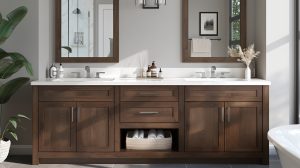
Choosing the Right Vanity Cabinet Style
With the range of vanity cabinet styles available, selecting one to complement your bathroom can feel overwhelming initially. However, keeping the size of your space and your personal tastes in mind helps narrow options. Consider the following popular styles:
Antique Vanities
Genuine antique vanities offer unmatched uniqueness and old-world appeal. Styling runs the gamut from the ornate carvings of the Victorian era to sleek, clean lines of Art Deco pieces. When paired with modern basin sinks and lighting, the visual contrast can be striking. Exact styling depends on the individual piece.
Reproduction and Vintage-Inspired Vanities
While offering uniqueness, sourcing genuine antique bathroom vanities can prove challenging. Quality reproductions and vintage-inspired new vanities capture the aesthetic at more accessible price points. Details like carved legs and base panels paired with distressed painting techniques recreate coveted antique looks. For small bathrooms, wall-mount single vanity units work especially well.
Transitional Vanity Cabinets
Transitional bedroom vanities blend elements of traditional and contemporary styling. Straightforward cabinet doors offset with tapered legs and modern hardware creates an adaptable look appealing to varied tastes. The simplicity showcases today’s wide range of counter surface and basin materials beautifully.
Modern and Contemporary Vanities
For bathrooms with a sleek, pared-back aesthetic, contemporary vanity cabinets bring clean lines and visual lightness. trading ornate detail for stripped-back forms. Floating single vanity units help small bathrooms feel more expansive. Modern materials like acrylic, glass, and metal lend these vanities a cutting-edge look.
Shaker Style Vanities
The ultimate in versatility, Shaker style vanities work in spaces from farmhouse rustic to urban modern. Their recessed panel doors and streamlined hardware bring subtle visual texture and dimension while suiting pared-back decor. Made from wood, the style’s simplicity also enables mixing materials like stone counters.
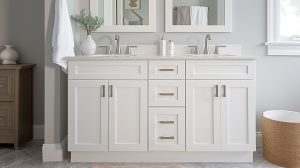
Understanding Materials and Finishes
Along with style, material choice plays a defining role in vanities’ aesthetic appeal and functionality. Bathroom humidity and splashing necessitate using wood and composites appropriately to safeguard vanities’ integrity and finish.
Wood Species
Traditional vanity cabinets rely on high-quality hardwoods for visual interest and resilience. Oak’s distinctive grain offers durability and stain acceptance while maple provides a smooth surface for painted finishes. Exotic zebrawood or walnut supply striking veining when stained. Carefully sourced woods bring environmental sustainability.
Engineered Wood Composites
Offering construction stability alongside mold/moisture resistance, engineered composites suit bathrooms well. Plywood construction prevents warping while MDF (medium density fiberboard) compositions give excellent surface smoothness for painting. Top choices include marine-grade water-resistant MDF and weather-resistant plywood.
Finishes
Protecting the wood surface and enhancing visual appeal, appropriate finish choice prevents water damage in bathroom settings. Factory-applied low-VOC stains, paints, and clear coats give superior moisture protection. On-site applications should use bathroom-appropriate polyurethane or conversion varnish for similar protection.
Distressed paint techniques involve applying color then sanding to mimic worn antique patinas. When paired with accent glazing, results recreate coveted timeworn styling on new vanities.
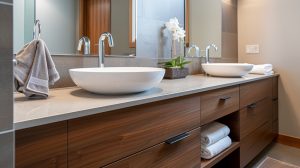
Sizing and Layout Considerations
Available in single and double basin configurations measuring from 24 to 72 inches, vanity size potentials are vast. Consider existing plumbing locations alongside cabinet clearance needs when selecting bathroom vanity size. Measure available floor space accurately; depth and width should include projecting elements like countertops and hardware.
Small Bathrooms
For petite baths, floating single vanities with thin depth profiles maximize floor space visually. Wall mounted styles remove leg overhang, while open bottom designs create an airy look. Drawer stacks help maximize storage.
Large Bathrooms
Oversized bathrooms suit wider double vanities allowing his and hers storage. Separating sinks let multiple users prep simultaneously. Deeper cabinets increase capacities while wider widths enhance spaciousness. Custom sizing beyond stock options tailors to specific layouts.
Oddly Shaped Rooms
Bathroom layouts transcending rectangles need thoughtful space planning when adding vanities. Adjust sizing for room proportions and existing plumbing. Curved and angled walls suit compact narrow vanities or floating cabinets. Remember to allow proper bathroom circulation routes.
Features and Functionality
Blending storage, style, and convenience, vanity features refine functionality. Well-designed pieces optimize organization while complementing your bath’s look.
Drawers and Doors
Available in below sink single stack or double stack configurations, drawers maximize storage for toiletries, hair, and makeup tools. Full extension slides enable accessing contents easily. Doors suit plumbing access and concealing larger items like towels neatly.
Open Shelf Storage
Trading concealed storage for display space, open shelving enables showcasing cared-for linens or decorative bath accessories. The lighter visual look suits small bathrooms well. Limit moisture exposure by avoiding direct water splashing onto surfaces.
Pull Out Storage
Making contents accessible without digging, pull out cabinetry keeps everything orderly yet hidden. Tiered trays accommodate various items neatly while full extension runners enable easy access. Surface mounted tambour doors streamline small bath storage discreetly.
Towel Storage
Incorporate dedicated towel storage into vanities or nearby cabinetry to limit moisture and clutter. Freestanding towel racks complement vanity facades while recessed vertical towers fit unobtrusively into tight spaces. Top surface towel bars allow grab and go convenience.
Drawer Organizers
Designate drawers for personal products or bathroom supplies then customize the interior arrangement to suit the contents. Adjustable compartments, trays, and inserts tailor to exact needs while preventing jumbled drawer contents messily.
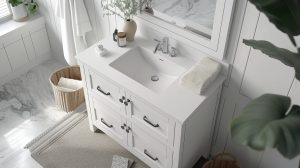
Installing a Bathroom Vanity Cabinet
Installing bathroom vanity cabinets requires careful planning alongside proper mounting provisions for safety. Poor installation risks destabilizing expensive cabinetry alongside potential water leakage.
Step 1) Confirm rough-in plumbing dimensions match the vanity space allowed. Adjust drain height to align with cabinet specifications before installing.
Step 2) Level the floor area where the vanity sits, adding shims if the substrate is uneven. Use caulking to seal the bottom edge completely to the floor.
Step 3) Fasten through the vanity back panel securely into wall studs or pre-installed cross-bracing supports. Wall anchors in drywall alone cannot withstand weight/use stresses.
Step 4) Attach countertop by pre-drilling edge locations to prevent splitting particleboard substrate. Hardware spacing of 4-6 inches provides security. Apply silicone caulk along the seam.
Step 5) Connect plumbing lines to faucet and drain assemblies. Check for concealed leaks before completing side paneling. Adjust doors/drawers that misalign.
Maintenance and Care Tips
Protecting beauty and function, properly caring for bathroom vanities preserves their integrity and visual appeal long term. Be mindful of moisture and cleaning agent aggressiveness.
Use gentle cleaners like diluted dish soap and avoid harsh chemicals that degrade protective finish layers over time. Distressed paint techniques remain vulnerable to wear until fully cured.
Dry surfaces thoroughly and never allow puddling water or splashing near wood cabinetry to prevent swelling and finish distortion. Promptly wipe spills.
Inspect drawer glides and hinges seasonally. Tighten hardware that loosens over time to prevent sagging and alignment issues. Lubricate sticky mechanisms with silicone spray.
Touch up scratches on factory finished vanities to protect against moisture intrusion and compromise. Use manufacturer-approved finish materials and prep carefully for color matching.
Consider glass shelves inside vanities to simplify cleaning and provide water resistance while still enabling some open display space. sturdy solid surface shelves resist warping.
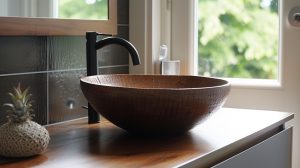
Enhancing Your Vanity with Accessories
The finest details finalize an appealing vanity arrangement. Well-chosen accessories put the finishing refinements on your bathroom focal point.
Basin Sinks and Faucets
Vessel, undermount or drop-in sinks pair beautifully with vanity cabinets as do widespread bridge faucets and single-handle models. Select sink and faucet finishes to complement your cabinetry. Glass and stone sinks provide brilliant visual contrast.
Mirrors
Hung alone or flanking sconces illuminate grooming tasks. Lean mirrors against walls or mount horizontally to make compact baths feel expanded. Antiqued mirrors, beveled edges and slim profiles add further dimension.
Sconces and Vanity Lighting
Attached wall sconces save counter space for bath accessories and cleansing items. Vanity strip lighting enables clear grooming task visibility. Mount individual vintage cage lights or contemporary LED strips centered on the mirror.
Bath Accessories
Decorative accoutrements give vanities finishing polish. Glass canisters display Q-tips and cotton rounds attractively. Ceramic toothbrush holders and soap pumps simplify accessing daily essentials.
Top Trends in Bathroom Vanity Cabinets
Alongside providing storage solutions, today’s vanity cabinet offerings enable personalized styling. Whether designing to impress guests or create an everyday refuge, options suit both form and function.
Mixed Materials
Juxtaposing contrasting textures and patterns, the mixed media trend livens conventional vanity arrangements. Thick stone countertops grounded by delicate turned wood legs make strong visual statements, as do sleek lacquer finishes adorned with woven rattan drawers.
Maximalist Accents
Increasingly popular, maximalism embraces vibrant color palettes, eclectic patterns and abundant textures for an exuberant look. While entire spaces risk overwhelming, adding bold vanity accents invigorates. Try eye-catching wallpaper or locally crafted ceramic knobs.
Custom Design
Removing size constraints, custom vanities cater to specific room dimensions and storage needs. Adapt cabinet depths to fit existing plumbing while minimizing unused floor space. Integrate specialty organizational components like rollout trays.
Sustainably Sourced Materials
Eco-conscious designers increasingly demand renewable and responsibly procured woods for vanities. Reclaimed timber, rapid-growth bamboo and Forest Stewardship Council-certified options bring green style alignment. Verify sourcing claims before purchase.
Budgeting and Shopping for a Vanity
With broad size configurations and vastly differing build qualities, today’s sea of vanity options makes cost comparisons challenging. Focus on long-term enjoyment within your budget to simplify selecting appropriately.
Concentrate less on bargain hunting brand names and instead evaluate construction methods and hardware quality indicators. Furniture joints should fit tightly without gaps or glue visibly oozing at seams. Slide drawers and doors open/closed to check alignment and smooth operation.
Well-constructed vanities seldom cost less than $500 given suitable wood species, durable finish applications and sturdy drawer/door hardware. $1000-$1500 secures mid-tier styles from reputable bathroom brands while custom room-sized versions often reach $3000 and beyond.
Set realistic expectations between budget, size capabilities, and longevity wants before beginning your search. Consider quality first over maximum dimensions to get satisfying everyday use for years to come. Your most reliable gauge lies in closely inspecting build. Simplicity of design allows focusing attention on those well-crafted details.